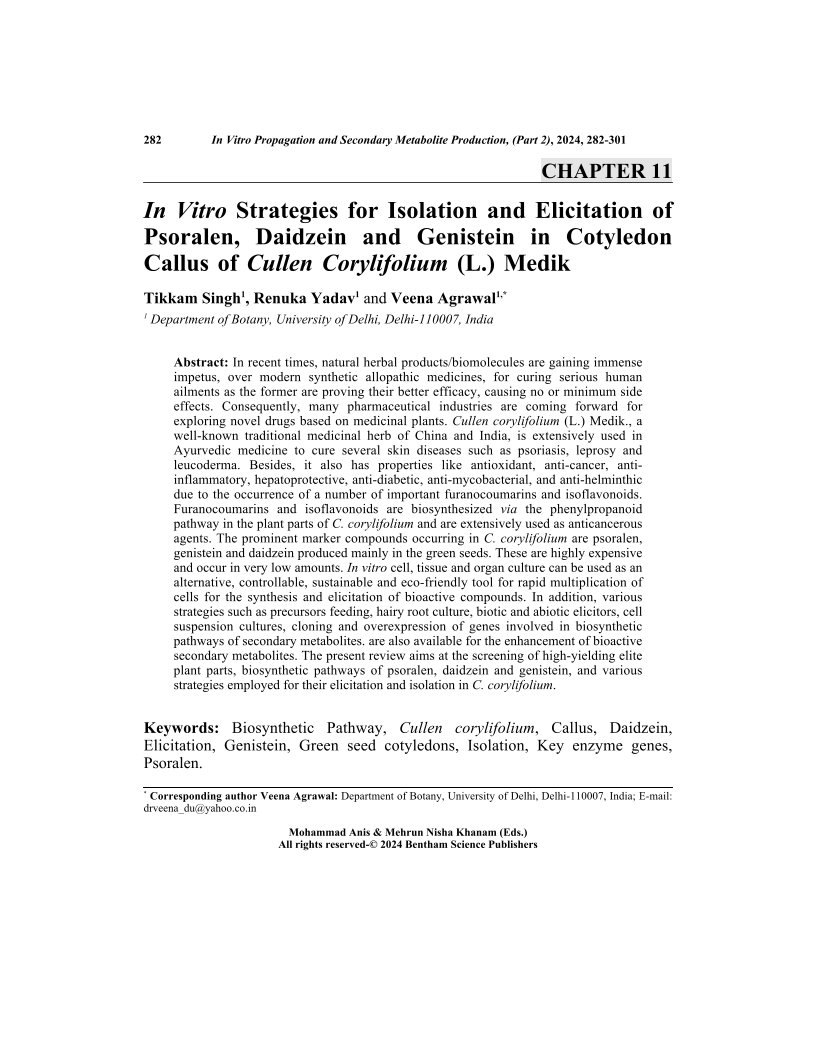- Home
- Books
- In Vitro Propagation and Secondary Metabolite Production from Medicinal Plants: Current Trends (Part 2)
- Chapter
In Vitro Strategies for Isolation and Elicitation of Psoralen, Daidzein and Genistein in Cotyledon Callus of Cullen Corylifolium (L.) Medik

- Authors: Tikkam Singh1, Renuka Yadav2, Veena Agrawal3
-
View Affiliations Hide AffiliationsAffiliations: 1 Department of Botany, University of Delhi, Delhi 110007, India 2 Department of Botany, University of Delhi, Delhi-110007, India 3 Department of Botany, University of Delhi, Delhi-110007, India
- Source: In Vitro Propagation and Secondary Metabolite Production from Medicinal Plants: Current Trends (Part 2) , pp 282-301
- Publication Date: April 2024
- Language: English
In Vitro Strategies for Isolation and Elicitation of Psoralen, Daidzein and Genistein in Cotyledon Callus of Cullen Corylifolium (L.) Medik, Page 1 of 1
< Previous page | Next page > /docserver/preview/fulltext/9789815196351/chapter-11-1.gif
In recent times, natural herbal products/biomolecules are gaining immense impetus, over modern synthetic allopathic medicines, for curing serious human ailments as the former are proving their better efficacy, causing no or minimum side effects. Consequently, many pharmaceutical industries are coming forward for exploring novel drugs based on medicinal plants. Cullen corylifolium (L.) Medik., a well-known traditional medicinal herb of China and India, is extensively used in Ayurvedic medicine to cure several skin diseases such as psoriasis, leprosy and leucoderma. Besides, it also has properties like antioxidant, anti-cancer, antiinflammatory, hepatoprotective, anti-diabetic, anti-mycobacterial, and anti-helminthic due to the occurrence of a number of important furanocoumarins and isoflavonoids. Furanocoumarins and isoflavonoids are biosynthesized via the phenylpropanoid pathway in the plant parts of C. corylifolium and are extensively used as anticancerous agents. The prominent marker compounds occurring in C. corylifolium are psoralen, genistein and daidzein produced mainly in the green seeds. These are highly expensive and occur in very low amounts. In vitro cell, tissue and organ culture can be used as an alternative, controllable, sustainable and eco-friendly tool for rapid multiplication of cells for the synthesis and elicitation of bioactive compounds. In addition, various strategies such as precursors feeding, hairy root culture, biotic and abiotic elicitors, cell suspension cultures, cloning and overexpression of genes involved in biosynthetic pathways of secondary metabolites. are also available for the enhancement of bioactive secondary metabolites. The present review aims at the screening of high-yielding elite plant parts, biosynthetic pathways of psoralen, daidzein and genistein, and various strategies employed for their elicitation and isolation in C. corylifolium.
-
From This Site
/content/books/9789815196351.chapter-11dcterms_subject,pub_keyword-contentType:Journal105

